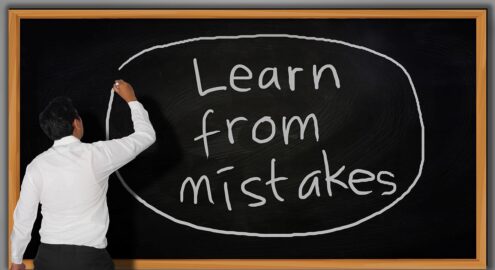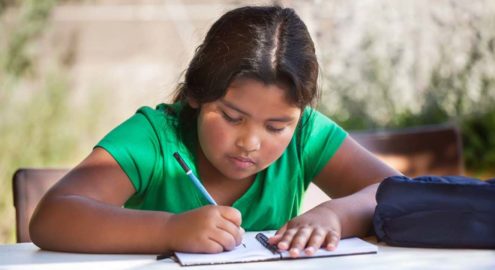What Is It?
The term language arts refers to the subjects that aim to develop students’ capacities to understand and use language. Here, we will focus on the core components of language arts, reading and writing, which provide ample opportunities to integrate prosocial development into the academic curriculum.
Reading Instruction
Prosocial instruction in reading involves emphasizing social-emotional and ethical themes, analysis, and experience when reading literature or other forms of texts with students. Using a prosocial lens in literacy learning can help students better understand themselves and others, examine moral dilemmas, and encourage them to practice compassion and other prosocial qualities in their everyday lives.
While reading aloud to his students, an elementary school teacher helps students become emotionally transported into stories by encouraging them to imagine what characters are seeing, hearing, touching, and so on. After reading, he pauses to discuss social-emotional questions that have arisen in the story, such as how characters are feeling and why, the reasons characters are behaving in a certain way, or how a character’s actions affect others.
A high school English teacher, when teaching literary fiction or life narratives, gives students the opportunity to think about and discuss the thoughts and feelings of people who may have very different experiences than their own, or who may offer new perspectives on familiar experiences. She then prompts students to make connections between issues in the text and in their own communities, and to think about how they could act to help.
Writing Instruction
Applying a prosocial lens in writing instruction can involve using writing to further examine and discuss prosocial themes in texts that students have read; especially in older grades, the teaching of writing is often integrated with literary analysis.
However, writing—especially in the form of narratives or poetry—can also offer students a unique chance to explore and express their own feelings, life experiences, and values.
At the beginning of the school year, high schoolers in English class are asked to write briefly about their most important values. As the year goes on, for each text they read, their teacher asks them to write a response identifying the main character’s central values, how these values influence the character’s actions, and how these values are similar to and different from their own.
As part of a poetry unit, a middle school teacher has her class read several poems that include descriptions of different emotional experiences. In addition to analyzing the technical features of the poems, they discuss the emotional qualities of each one, and students write responses about how one or more of the poems produces an emotional effect. Then, students are assigned to write their own poems about an emotional experience in their lives that they are willing to share, and are each given the opportunity to perform their poem for the class if they would like.
Why Is It Important?
The potential of reading to promote prosocial skills, especially empathy, has long been recognized by research. The research on using writing in ways that promote well-being is more limited, but early studies are promising. Here are some of the findings:
Reading fiction helps us understand others.
- Research suggests that people who read more fiction and literature, and who allow themselves to be emotionally transported by a story, tend to be more empathetic.
- Brain imaging studies show that the same brain regions are activated while reading fiction as with real-life experience, and that the parts of the brain involved in story comprehension overlap with those involved in theory of mind (the ability to infer and understand that others can think differently than oneself).
- Reading literary fiction in particular, compared with popular fiction or nonfiction, seems to improve theory of mind.
Reading encourages us to act in more prosocial (kind and helpful) ways.
- Actively imagining a story coming to life in all its sensory glory can increase empathy and prosocial behavior.
- Reading life narratives may increase a person’s willingness to donate to a related cause.
- Even for children as young as preschool, discussing social-emotional issues after reading together relates to greater moral understanding and more prosocial behavior.
Motivation to read and prosocial behavior are connected.
- Students who feel that they belong and that their teacher cares for them tend to be more motivated to read.
- And students who want to read also tend to have more motivation to be kind and helpful in their classrooms.
Expressing ourselves through writing promotes well-being.
- Expressive writing, especially about emotional or stressful experiences, can help students explore rather than suppress their feelings, and has been shown to promote both physical health (including symptom reduction) and psychological well-being in the long term; it may increase short-term distress, however, so should be used with caution.
Poetry is powerful.
- Using a poetry therapy model (reading and writing responses to others’ poems as well as writing one’s own) in literature classrooms shows promise for engaging with emotions and improving well-being; studies have shown that use of this model may reduce anxiety, depression, and stress in young people.
- Early evidence also indicates that reading and writing poetry may be helpful for increasing empathy, especially for others from different backgrounds than one’s own, or when empathy is challenging.
- For some students, performing poetry, such as in a poetry slam, may offer additional community-building benefits.
Writing about prosociality encourages us to be more prosocial.
- Whether it’s elementary schoolers writing reports of peers’ prosocial actions or adolescents completing a written exercise affirming their values, writing about prosocial topics has been shown to increase students’ own prosocial behavior in a lasting way.
Practice Collections
Practices

Seeds of Self-Compassion

Promoting Perspective-Taking Through the Use of Literature

Exemplars Who Inspire Intellectual Humility

Compass Points

Tug for Truth

Respectful Debate

Yes-No-Maybe Current Event Discussion

Norm Co-Creation

Strategies for Teaching Fearless SEL for Societal Change

Questions of Wonder

Mindful Poetry Moments

Earthrise: Bearing Witness to Our Planet

Earthrise: Fostering Awe

Earthrise: Instilling Reverence for the Earth

What Is A Flourishing Life?

Reading Ourselves Whole: A Contemplative Choral Reading Method

“The Guest House” Poem and Body Scan for Teens

Contemplative Writing

Do you want to dive deeper into the science behind our GGIE practices? Enroll in one of our online courses for educators!



